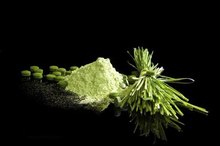What does fact checked mean?
At Healthfully, we strive to deliver objective content that is accurate and up-to-date. Our team periodically reviews articles in order to ensure content quality. The sources cited below consist of evidence from peer-reviewed journals, prominent medical organizations, academic associations, and government data.
The information contained on this site is for informational purposes only, and should not be used as a substitute for the advice of a professional health care provider. Please check with the appropriate physician regarding health questions and concerns. Although we strive to deliver accurate and up-to-date information, no guarantee to that effect is made.
Pewter & Lead Safety
Many people have concerns about using pewter in their daily lives, whether it is for tableware, such as old-fashioned pewter plates, mugs or drinking steins, or for personal adornment in the form of jewelry. Such concerns are often unfounded, as the only danger in pewter lies in its lead content, and all quality pewter made after the late 1700s in America and Britain is lead-free. When dealing with antique pewter or pewter of unknown origin, however, you should take a few minor safety precautions.
Composition
Antique pewter is a metal alloy composed of tin and lead. The tin lends the metal its silvery color while the lead gives it additional strength. The alloy is primarily tin, at about a 90 percent concentration or higher. Modern pewter is still a tin-based alloy, but instead of potentially toxic lead, the tin is mixed with copper and antimony. These two metals strengthen the tin without lending the additional weight and potential toxicity of lead. Modern pewter is also known by the names Britannia pewter, Britannia metal and sometimes simply white metal 2. Tin still comprises approximately 92 percent of modern pewter, with 7.5 percent antimony and 0.5 percent copper as the standard alloy.
- Antique pewter is a metal alloy composed of tin and lead.
- Modern pewter is still a tin-based alloy, but instead of potentially toxic lead, the tin is mixed with copper and antimony.
Toxicity
How to Remove Lead From the Body
Learn More
Lead is a common element in the world; most people come into contact with it daily without danger. Only when lead is ingested does it cause damage. When dealing with pewter that contains lead, this ingestion commonly occurs through eating or drinking food from pewter vessels. Lead can leach into food from the pewter container, particularly with more acidic foods, leading to heightened lead content in the food. Lead may also be inhaled when cutting through old pewter items that contain lead, as the action of the saw can send lead-containing dust into the air, which is then drawn into the lungs. Inhaling lead fumes while melting antique pewter can also lead to lead toxicity.
- Lead is a common element in the world; most people come into contact with it daily without danger.
- Lead may also be inhaled when cutting through old pewter items that contain lead, as the action of the saw can send lead-containing dust into the air, which is then drawn into the lungs.
Considerations
Heating food in pewter dishes that contain lead can cause more lead to leach into food than would occur at cold temperatures. More acidic foods, such as those containing tomatoes, vinegar and citrus, also cause higher amounts of lead to leach from the pewter into the food.
Symptoms
Toxic Effects on Brain From Enamel Paint
Learn More
Lead poisoning affects adults and children in different ways. Symptoms of lead poisoning in adults can begin with seemingly innocent changes such as lethargic behavior, extreme irritability and difficulty remembering things, according to Ohio State University 3. At more concentrated levels, lead affects the hemoglobin significantly and can cause seizures, kidney failure and death. Pediatric (childhood) lead toxicity also affects the hemoglobin, but because children's systems are still developing it can lead to slowed mental and physical growth, anemia and damage to hearing, notes the Mayo Clinic.
Risk
Even with pewter that contains lead, risk of lead poisoning from ingestion is fairly low in adults, since only 5 to 10 percent of the lead that enters the body through the digestive tract will pass into the bloodstream. Therefore, a single exposure is highly unlikely to cause lead poisoning, which most often occurs in adults who work with lead directly and receive repeated exposure to its dust and fumes. Children are at higher risk for lead poisoning than adults, from pewter or any other source, because their bodies are still developing and their relatively high metabolisms process toxins in the blood more quickly. Children may put pewter jewelry into their mouths if left unattended, gaining lead exposure directly from the metal if it is an alloy that contains lead.
- Even with pewter that contains lead, risk of lead poisoning from ingestion is fairly low in adults, since only 5 to 10 percent of the lead that enters the body through the digestive tract will pass into the bloodstream.
- Therefore, a single exposure is highly unlikely to cause lead poisoning, which most often occurs in adults who work with lead directly and receive repeated exposure to its dust and fumes.
Advice
If you are unsure whether any pewter element in your home contains lead, do not put it into contact with food and keep it out of reach of children. Do not attempt to cut, melt or otherwise physically alter the object. When used simply for ornamental purposes, all types of pewter are safe.
Related Articles
References
Writer Bio
Anne Hirsh has been writing and editing for over 10 years. She has hands-on experience in cooking, visual arts and theater as well as writing experience covering wellness and animal-related topics. She also has extensive research experience in marketing, small business, Web development and SEO. Hirsh has a bachelor's degree in technical theater and English and post-baccalaureate training in writing and computer software.









